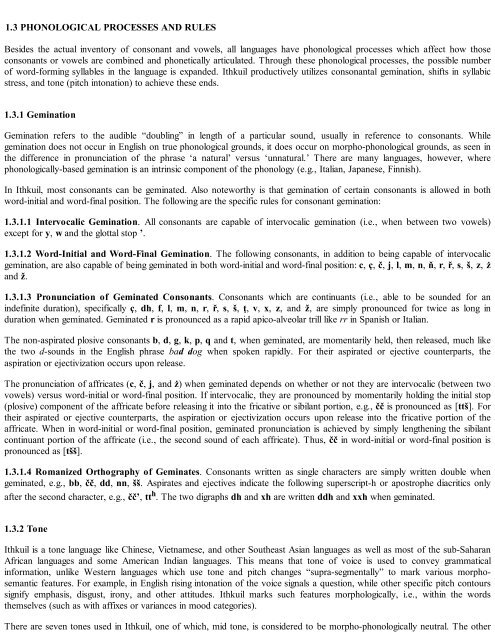logical language - Developers
logical language - Developers
logical language - Developers
You also want an ePaper? Increase the reach of your titles
YUMPU automatically turns print PDFs into web optimized ePapers that Google loves.
1.3 PHONOLOGICAL PROCESSES AND RULES<br />
Besides the actual inventory of consonant and vowels, all <strong>language</strong>s have phono<strong>logical</strong> processes which affect how those<br />
consonants or vowels are combined and phonetically articulated. Through these phono<strong>logical</strong> processes, the possible number<br />
of word-forming syllables in the <strong>language</strong> is expanded. Ithkuil productively utilizes consonantal gemination, shifts in syllabic<br />
stress, and tone (pitch intonation) to achieve these ends.<br />
1.3.1 Gemination<br />
Gemination refers to the audible “doubling” in length of a particular sound, usually in reference to consonants. While<br />
gemination does not occur in English on true phono<strong>logical</strong> grounds, it does occur on morpho-phono<strong>logical</strong> grounds, as seen in<br />
the difference in pronunciation of the phrase ‘a natural’ versus ‘unnatural.’ There are many <strong>language</strong>s, however, where<br />
phono<strong>logical</strong>ly-based gemination is an intrinsic component of the phonology (e.g., Italian, Japanese, Finnish).<br />
In Ithkuil, most consonants can be geminated. Also noteworthy is that gemination of certain consonants is allowed in both<br />
word-initial and word-final position. The following are the specific rules for consonant gemination:<br />
1.3.1.1 Intervocalic Gemination. All consonants are capable of intervocalic gemination (i.e., when between two vowels)<br />
except for y, w and the glottal stop ’.<br />
1.3.1.2 Word-Initial and Word-Final Gemination. The following consonants, in addition to being capable of intervocalic<br />
gemination, are also capable of being geminated in both word-initial and word-final position: c, ç, č, j, l, m, n, ň, r, ř, s, š, z, ż<br />
and ž.<br />
1.3.1.3 Pronunciation of Geminated Consonants. Consonants which are continuants (i.e., able to be sounded for an<br />
indefinite duration), specifically ç, dh, f, l, m, n, r, ř, s, š, ţ, v, x, z, and ž, are simply pronounced for twice as long in<br />
duration when geminated. Geminated r is pronounced as a rapid apico-alveolar trill like rr in Spanish or Italian.<br />
The non-aspirated plosive consonants b, d, g, k, p, q and t, when geminated, are momentarily held, then released, much like<br />
the two d-sounds in the English phrase bad dog when spoken rapidly. For their aspirated or ejective counterparts, the<br />
aspiration or ejectivization occurs upon release.<br />
The pronunciation of affricates (c, č, j, and ż) when geminated depends on whether or not they are intervocalic (between two<br />
vowels) versus word-initial or word-final position. If intervocalic, they are pronounced by momentarily holding the initial stop<br />
(plosive) component of the affricate before releasing it into the fricative or sibilant portion, e.g., čč is pronounced as [ttš]. For<br />
their aspirated or ejective counterparts, the aspiration or ejectivization occurs upon release into the fricative portion of the<br />
affricate. When in word-initial or word-final position, geminated pronunciation is achieved by simply lengthening the sibilant<br />
continuant portion of the affricate (i.e., the second sound of each affricate). Thus, čč in word-initial or word-final position is<br />
pronounced as [tšš].<br />
1.3.1.4 Romanized Orthography of Geminates. Consonants written as single characters are simply written double when<br />
geminated, e.g., bb, čč, dd, nn, šš. Aspirates and ejectives indicate the following superscript-h or apostrophe diacritics only<br />
after the second character, e.g., čč’, tt h . The two digraphs dh and xh are written ddh and xxh when geminated.<br />
1.3.2 Tone<br />
Ithkuil is a tone <strong>language</strong> like Chinese, Vietnamese, and other Southeast Asian <strong>language</strong>s as well as most of the sub-Saharan<br />
African <strong>language</strong>s and some American Indian <strong>language</strong>s. This means that tone of voice is used to convey grammatical<br />
information, unlike Western <strong>language</strong>s which use tone and pitch changes “supra-segmentally” to mark various morphosemantic<br />
features. For example, in English rising intonation of the voice signals a question, while other specific pitch contours<br />
signify emphasis, disgust, irony, and other attitudes. Ithkuil marks such features morpho<strong>logical</strong>ly, i.e., within the words<br />
themselves (such as with affixes or variances in mood categories).<br />
There are seven tones used in Ithkuil, one of which, mid tone, is considered to be morpho-phono<strong>logical</strong>ly neutral. The other


